+ Open data
Open data
- Basic information
Basic information
| Entry | Database: PDB / ID: 7jsj | ||||||||||||||||||||||||
|---|---|---|---|---|---|---|---|---|---|---|---|---|---|---|---|---|---|---|---|---|---|---|---|---|---|
| Title | Structure of the NaCT-PF2 complex | ||||||||||||||||||||||||
 Components Components | Solute carrier family 13 member 5 | ||||||||||||||||||||||||
 Keywords Keywords | MEMBRANE PROTEIN / Transporter / Inhibitor | ||||||||||||||||||||||||
| Function / homology |  Function and homology information Function and homology informationoxaloacetate transport / organic acid:sodium symporter activity / fumarate transport / succinate transport / sodium:dicarboxylate symporter activity / citrate transmembrane transporter activity / citrate transport / alpha-ketoglutarate transport / Sodium-coupled sulphate, di- and tri-carboxylate transporters / succinate transmembrane transporter activity ...oxaloacetate transport / organic acid:sodium symporter activity / fumarate transport / succinate transport / sodium:dicarboxylate symporter activity / citrate transmembrane transporter activity / citrate transport / alpha-ketoglutarate transport / Sodium-coupled sulphate, di- and tri-carboxylate transporters / succinate transmembrane transporter activity / cellular response to lithium ion / transmembrane transport / nucleoplasm / identical protein binding / plasma membrane / cytosol Similarity search - Function | ||||||||||||||||||||||||
| Biological species |  Homo sapiens (human) Homo sapiens (human) | ||||||||||||||||||||||||
| Method | ELECTRON MICROSCOPY / single particle reconstruction / cryo EM / Resolution: 3.12 Å | ||||||||||||||||||||||||
 Authors Authors | Sauer, D.B. / Wang, B. / Song, J. / Rice, W.J. / Wang, D.N. | ||||||||||||||||||||||||
| Funding support |  United States, 7items United States, 7items
| ||||||||||||||||||||||||
 Citation Citation |  Journal: Nature / Year: 2021 Journal: Nature / Year: 2021Title: Structure and inhibition mechanism of the human citrate transporter NaCT. Authors: David B Sauer / Jinmei Song / Bing Wang / Jacob K Hilton / Nathan K Karpowich / Joseph A Mindell / William J Rice / Da-Neng Wang /  Abstract: Citrate is best known as an intermediate in the tricarboxylic acid cycle of the cell. In addition to this essential role in energy metabolism, the tricarboxylate anion also acts as both a precursor ...Citrate is best known as an intermediate in the tricarboxylic acid cycle of the cell. In addition to this essential role in energy metabolism, the tricarboxylate anion also acts as both a precursor and a regulator of fatty acid synthesis. Thus, the rate of fatty acid synthesis correlates directly with the cytosolic concentration of citrate. Liver cells import citrate through the sodium-dependent citrate transporter NaCT (encoded by SLC13A5) and, as a consequence, this protein is a potential target for anti-obesity drugs. Here, to understand the structural basis of its inhibition mechanism, we determined cryo-electron microscopy structures of human NaCT in complexes with citrate or a small-molecule inhibitor. These structures reveal how the inhibitor-which binds to the same site as citrate-arrests the transport cycle of NaCT. The NaCT-inhibitor structure also explains why the compound selectively inhibits NaCT over two homologous human dicarboxylate transporters, and suggests ways to further improve the affinity and selectivity. Finally, the NaCT structures provide a framework for understanding how various mutations abolish the transport activity of NaCT in the brain and thereby cause epilepsy associated with mutations in SLC13A5 in newborns (which is known as SLC13A5-epilepsy). | ||||||||||||||||||||||||
| History |
|
- Structure visualization
Structure visualization
| Movie |
 Movie viewer Movie viewer |
|---|---|
| Structure viewer | Molecule:  Molmil Molmil Jmol/JSmol Jmol/JSmol |
- Downloads & links
Downloads & links
- Download
Download
| PDBx/mmCIF format |  7jsj.cif.gz 7jsj.cif.gz | 319.3 KB | Display |  PDBx/mmCIF format PDBx/mmCIF format |
|---|---|---|---|---|
| PDB format |  pdb7jsj.ent.gz pdb7jsj.ent.gz | 262.2 KB | Display |  PDB format PDB format |
| PDBx/mmJSON format |  7jsj.json.gz 7jsj.json.gz | Tree view |  PDBx/mmJSON format PDBx/mmJSON format | |
| Others |  Other downloads Other downloads |
-Validation report
| Summary document |  7jsj_validation.pdf.gz 7jsj_validation.pdf.gz | 954.5 KB | Display |  wwPDB validaton report wwPDB validaton report |
|---|---|---|---|---|
| Full document |  7jsj_full_validation.pdf.gz 7jsj_full_validation.pdf.gz | 971.6 KB | Display | |
| Data in XML |  7jsj_validation.xml.gz 7jsj_validation.xml.gz | 33.4 KB | Display | |
| Data in CIF |  7jsj_validation.cif.gz 7jsj_validation.cif.gz | 48.1 KB | Display | |
| Arichive directory |  https://data.pdbj.org/pub/pdb/validation_reports/js/7jsj https://data.pdbj.org/pub/pdb/validation_reports/js/7jsj ftp://data.pdbj.org/pub/pdb/validation_reports/js/7jsj ftp://data.pdbj.org/pub/pdb/validation_reports/js/7jsj | HTTPS FTP |
-Related structure data
| Related structure data |  22456MC  7jskC M: map data used to model this data C: citing same article ( |
|---|---|
| Similar structure data |
- Links
Links
- Assembly
Assembly
| Deposited unit | 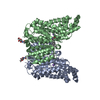
|
|---|---|
| 1 |
|
- Components
Components
| #1: Protein | Mass: 63110.812 Da / Num. of mol.: 2 Source method: isolated from a genetically manipulated source Source: (gene. exp.)  Homo sapiens (human) / Gene: SLC13A5, NACT / Production host: Homo sapiens (human) / Gene: SLC13A5, NACT / Production host:  Trichoplusia ni (cabbage looper) / References: UniProt: Q86YT5 Trichoplusia ni (cabbage looper) / References: UniProt: Q86YT5#2: Sugar | #3: Chemical | #4: Chemical | ChemComp-NA / Has ligand of interest | Y | Has protein modification | Y | |
|---|
-Experimental details
-Experiment
| Experiment | Method: ELECTRON MICROSCOPY |
|---|---|
| EM experiment | Aggregation state: PARTICLE / 3D reconstruction method: single particle reconstruction |
- Sample preparation
Sample preparation
| Component | Name: Dimer of NaCT in complex with PF2 / Type: ORGANELLE OR CELLULAR COMPONENT / Entity ID: #1 / Source: RECOMBINANT |
|---|---|
| Molecular weight | Value: 0.125 MDa / Experimental value: YES |
| Source (natural) | Organism:  Homo sapiens (human) Homo sapiens (human) |
| Source (recombinant) | Organism:  Trichoplusia ni (cabbage looper) Trichoplusia ni (cabbage looper) |
| Buffer solution | pH: 7.5 |
| Specimen | Embedding applied: NO / Shadowing applied: NO / Staining applied: NO / Vitrification applied: YES |
| Vitrification | Instrument: FEI VITROBOT MARK IV / Cryogen name: ETHANE / Humidity: 100 % / Chamber temperature: 277.15 K |
- Electron microscopy imaging
Electron microscopy imaging
| Experimental equipment |  Model: Titan Krios / Image courtesy: FEI Company |
|---|---|
| Microscopy | Model: FEI TITAN KRIOS |
| Electron gun | Electron source:  FIELD EMISSION GUN / Accelerating voltage: 300 kV / Illumination mode: FLOOD BEAM FIELD EMISSION GUN / Accelerating voltage: 300 kV / Illumination mode: FLOOD BEAM |
| Electron lens | Mode: BRIGHT FIELD / Nominal magnification: 22500 X / Nominal defocus max: 2300 nm / Nominal defocus min: 1300 nm / Cs: 2.7 mm / C2 aperture diameter: 70 µm |
| Image recording | Average exposure time: 10 sec. / Electron dose: 69.42 e/Å2 / Film or detector model: GATAN K3 (6k x 4k) |
- Processing
Processing
| Software | Name: PHENIX / Version: 1.18_3855: / Classification: refinement | |||||||||||||||||||||||||||
|---|---|---|---|---|---|---|---|---|---|---|---|---|---|---|---|---|---|---|---|---|---|---|---|---|---|---|---|---|
| EM software |
| |||||||||||||||||||||||||||
| CTF correction | Type: PHASE FLIPPING AND AMPLITUDE CORRECTION | |||||||||||||||||||||||||||
| Symmetry | Point symmetry: C1 (asymmetric) | |||||||||||||||||||||||||||
| 3D reconstruction | Resolution: 3.12 Å / Resolution method: FSC 0.143 CUT-OFF / Num. of particles: 600496 / Symmetry type: POINT | |||||||||||||||||||||||||||
| Refine LS restraints |
|
 Movie
Movie Controller
Controller






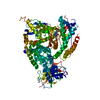

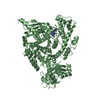
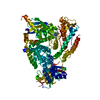


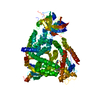
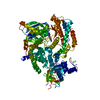
 PDBj
PDBj





